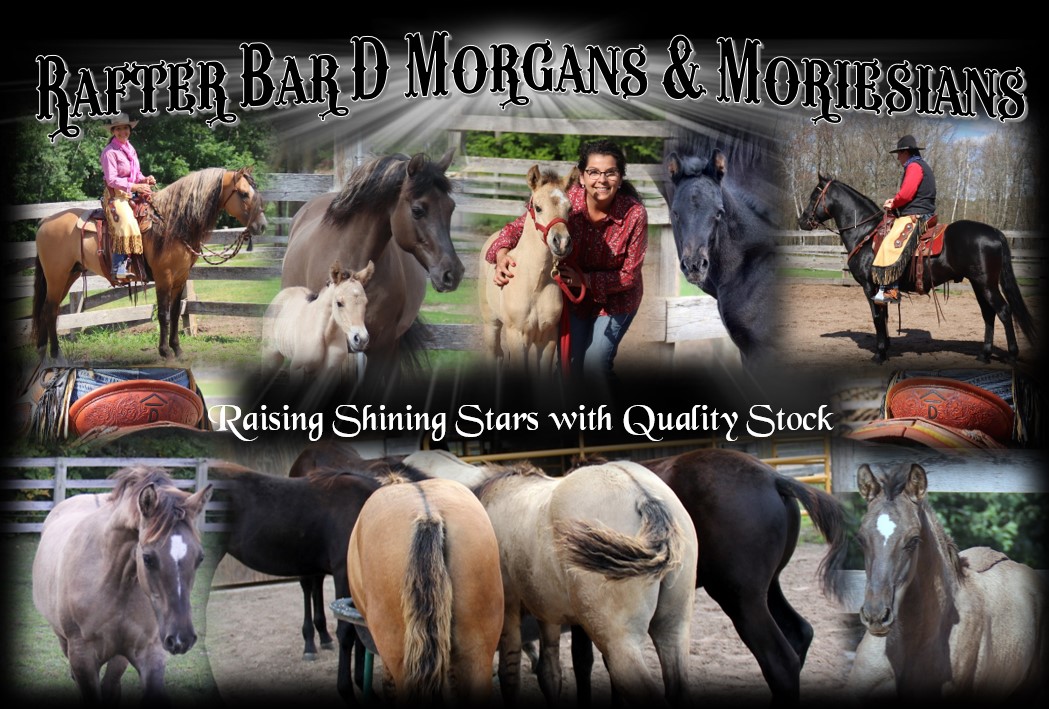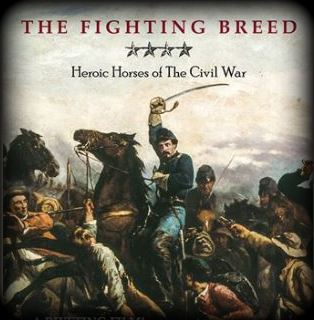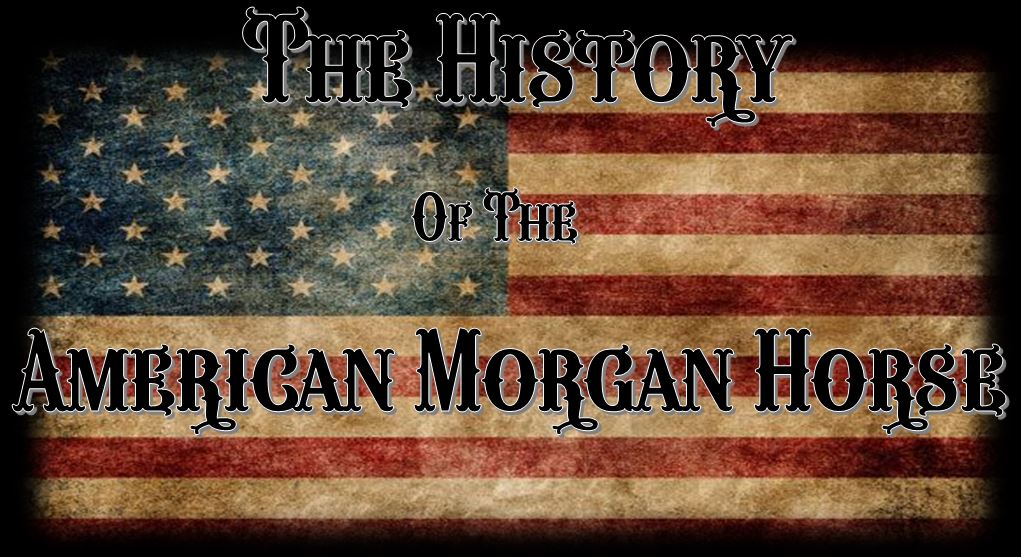
Thank you for your interest in the history of the Morgan horse. The first American breed helping to develop our nation.
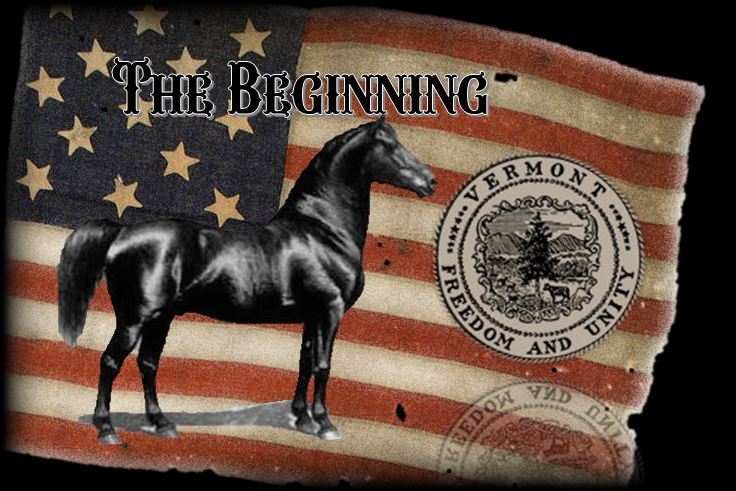
The founding stallion of the Morgan breed traces back to one Morgan horse known as Figure. He was born in southern New England in 1789. Figure's legacy began when a man named Justin Morgan purchased him as a foal and took him to Vermont in 1791. Justin Morgan was a horse breeder, farmer and teacher of singing who settled in Vermont and traveled throughout eastern states.
As Figure grew he became known for his strength, speed, beauty, endurance, hardiness and gentle disposition. It is thought that Figure stood approx. 14H and weighed 950 lbs. His ability to outwalk, outtrot, outrun and outpull any horse made him a legend. He was at stud in the east and he stamped himself not only on his offspring, but for several generations. Figure died in 1821. Three of his more famous sons were, Sherman, Bulrush and Woodbury who carried on the legacy.
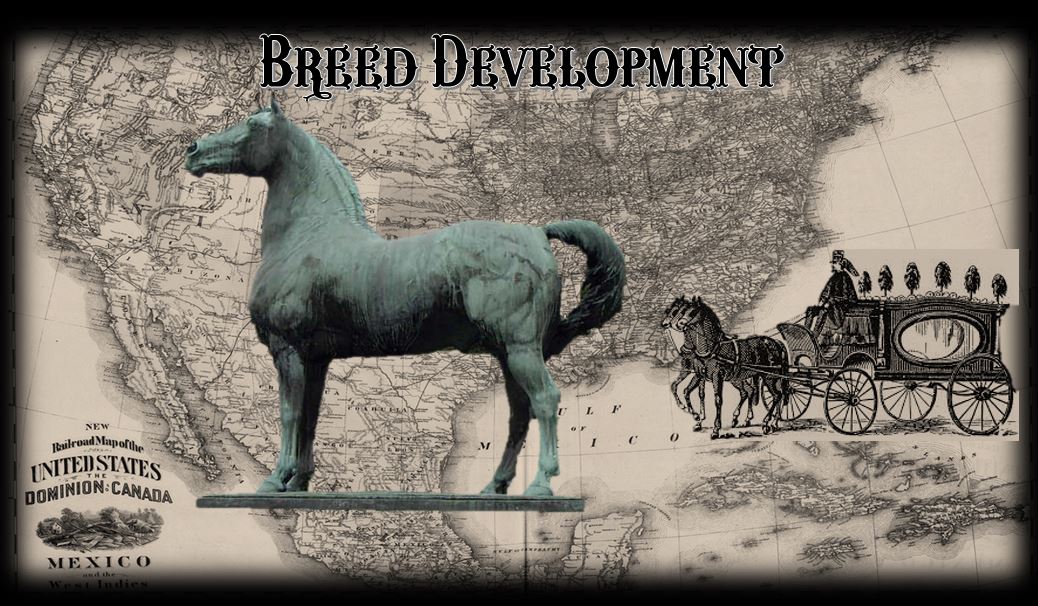
As our nation grew, so did the Morgan breed. The versatility of the Morgan was defining itself. Morgans were one of the most desirable horses for work, pleasure and sport in this countries' early development. Their diversity was unlimited.
The breed's trotting ability made them a favorite for harness racing in the 1840's. In the beginning Morgans set world trotting records. During the Civil War the Morgan was the cavalry's mount of choice. Their ability to endure the conditions of the war and outlast other breeds made them highly desirable. Many Morgans were lost in the Civil War.
Later in the 19th century taller horses were sought after. The desire for the Morgan horse began to decline. Many Morgan mares were bred to bigger stallions that were not Morgans. Breeders were hoping for all the enduring qualities of the Morgan with size that would result in a more marketable horse. This practice helped to develop other breeds and was the result of a major decline in the Morgan breed during this time.
In the 1890's efforts were made to bring the Morgan breed back. Many breeding programs were developed that are the foundation for our breeding programs of today. During this time the construction of the complex in Shelburne, Vermont was built. It was the home for the American Morgan Horse Association, the National Museum of the Morgan Horse for many years and has since been sold. AMHA still remains in Shelburne, Vermont at a different location.
The Fighting Breed: Heroic Horses of the Civil War
I'm so happy to share that there is finally a documentary film about our heroic Morgan horses in the Civil War. You can click the photo to the left to visit "A New Horse for a New County" website that celebrates the Morgan horse in America's history. You can preview the film at this site and order your own copy if you like.
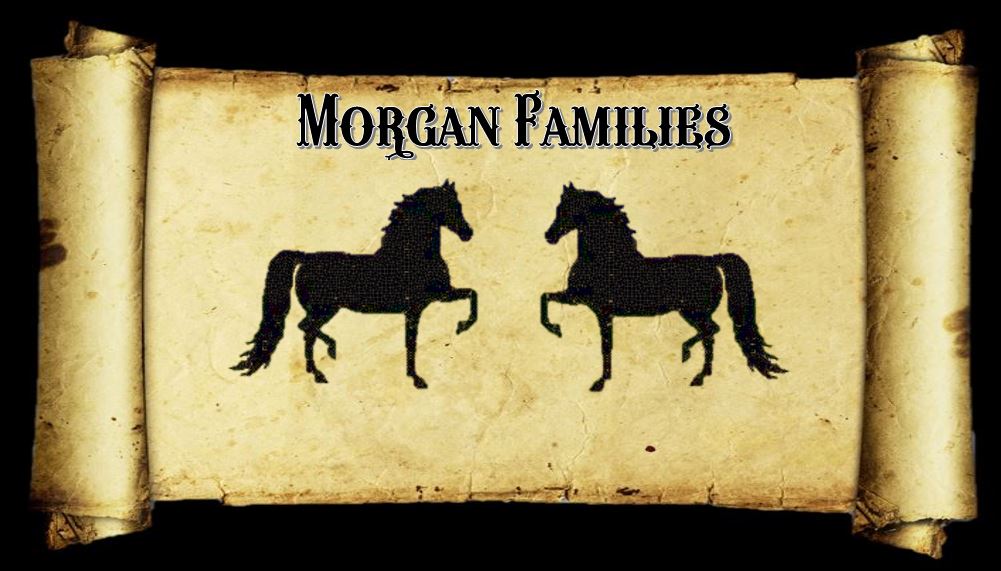
The Morgan families are a group of closely related horses that share specific characteristics in temperament, talent and conformation all within the Morgan breed. These families consist of Government, Brunk, Lippit and Western Working Lines.
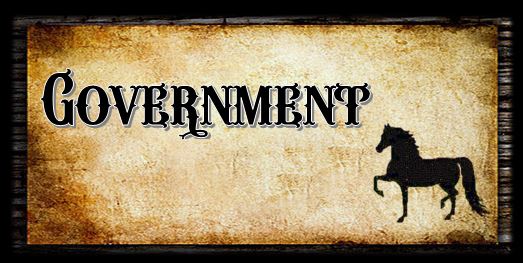
In 1905 an experiment farm was established by the U. S. Government in Burlington, Vermont to produce Morgan horses of true Morgan type, while increasing size yet retaining all the Morgan's traditional enduring qualities. In 1907, Col. Joseph Battell, who was the first editor of the American Morgan Horse Register, donated his family farm in Weybridge, Vermont. The horses from the experiment farm were relocated to Weybridge and the United States Morgan Horse Farm was established.
The foundation stallion for the government farm was General Gates, foaled in 1894. He remained the primary breeding stallion until 1920. One of his son's, Bennington, took his place in 1925. Bennington was the primary sire for the calvary mounts and sired many influential government morgans.
Some of the best known stallions in government breeding are General Gates, Mansfield, Canfield, Sonfield, Mentor, Ulysses, Querido, Troubadour of Willomoor, Panfield, Trophy, Tutor, Upwey Ben Don, and Fleetwing.
Some of the well known mares include Artemisia, Quietude, Sheba, Redfern, Quaker Lady, Norma, Naiad, Jasmine, Romance, Symphony, Fairytop, Phillipa, and Riviera.
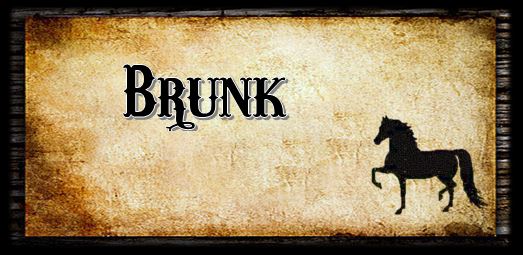
In 1893 Joseph Brunk and his family established the Brunk line in and around Springfield, IL. Joseph Brunk had a serious interest in morgans and his sharp sense for horses led him to raise some of the most influential Morgans of all time. These horses were known for their high action, sound, correct legs and feet and all around athletic ability. They were often line-bred and usually high quality, showy horses. The Brunk influence is felt strongly in the ranch breeding of the west known as the Western Working family of morgans.
Flyhawk was the most widely known stallion of the Brunk family. He sired many great Morgans and his influence is still seen in many breeding programs today. He was noted for his big ground covering trot, dense bone, hardiness and athleticism.
Some of the well known stallions in Brunk breeding are Beamington, Warhawk, Flyhawk, Jubilee King, Senator Graham, Senator Knox, Mr. Breezy Cobra, Congo, Go Hawk, Stetson, Red Vermont, Agizzaz, Flying Jubilee, Juzan, and Allen Franklin.
Some of the well known mares include, Senata, Florette, Sentola, Daisy Knox, Bens Daisy, Jubilee Joy, Sentana, Daisette, Liza Jane, Neliza, Paragraph and Juvina.
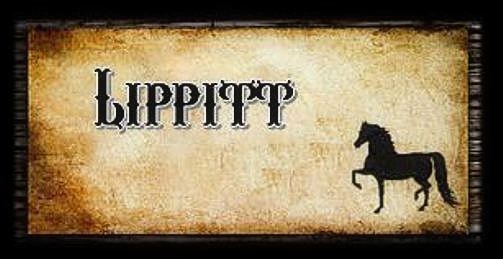
In 1927 Robert Lippitt Knight, a prominent figure in RI, established and operated the Green Mountain Stock Farm in Randolph, VT. The Lippitt family was established to preserve the original Morgan type. Mr. Knight bred almost exclusively to old vermont stock, however, he did outcross to government and other lines.
In the early 1970's a small group of New England breeders with a passion for the Morgan, who more closely mirrored Figure, gathered together. After much work 7 stallions and 16 mares were chosen for the foundation stock of the Lippitt family. Many of the horses chosen included the breeding from Robert Lippitt Knight, and to honor his preservation for the old bloodlines the name Lippitt was chosen for the family of horses.
One of the most influential stallions in the Lippitt family was Ethan Allen 2nd, bred by the Peters family of Bradford, VT.
Some of the best known foundation stallions in Lippitt breeding are Ethan Allen 2nd, Peter's Morgan, Croydon Prince, Rob Roy, Donald, Bob B., Sir Ethan Allen, Sealect, Welcome, and Bilirubin.
Some of the foundation mares include Bonnie Jean, Polly Rogers, Lucille, Rose of Sutton, Hannah, Susie,Croydon Mary,Bridget, Emily, Evelyn, Hippolyta, Nancy, Trilby, Jenny Woodbury, Lippit Sally, and Lippit Trixie.

Between 1880 and 1950 the Western Working family of morgans developed by several ranchers and breeders in the western states. With the cattle ranching empire rapidly expanding in the mid 1800's, there was a need for tough, agile, sensible cow horses to work on ranches. The Western Working Morgan derived from a combination of old Vermont, Government, Brunk and old midwest bloodlines.
The result is a family of Morgans noted for good feet and legs, deep bodies, strong hind quarters with a fast ground covering walk and trot, and stamina. They also needed an intelligent, sensible, willing attitude with lots of heart and cow saavy. Today there are still decendents being bred from the early Western Working Morgans. The bloodlines used were a combination of Brunk and Government breeding.
Some of the famous ranches instrumental in creating the Western Working family are the Sellman Ranch, Horseshoe Cattle Co., Piedmont Land and Cattle Co., Elmer Brown, E.W. Roberts, Jackson Ranch, L. U. Sheep and Cattle Co., and The Cross Ranch.
Some of the stallions that are influential in the Western Working families are Red Oak, The Admiral, Headlight Morgan, Major Antoine, Gold Medal, Querido, Winchester, El Cortez, Sonfield, Sparbeau, Redwood Morgan Sellman, Montcrest Sellman, Romanesque, Sellman Linsley, Tehachapi Allen, Monterey, Blackman, Delbert, Flyhawk, Linspar, Senator Graham, Stetson, Flying Jubilee, Glider and Warhawk.
Morgan History is so interesting and diverse. Today Morgans can be found in all 50 states and more than 20 foreign countries. Regardless of the family of morgans, the Morgan horse stands out in the crowd.
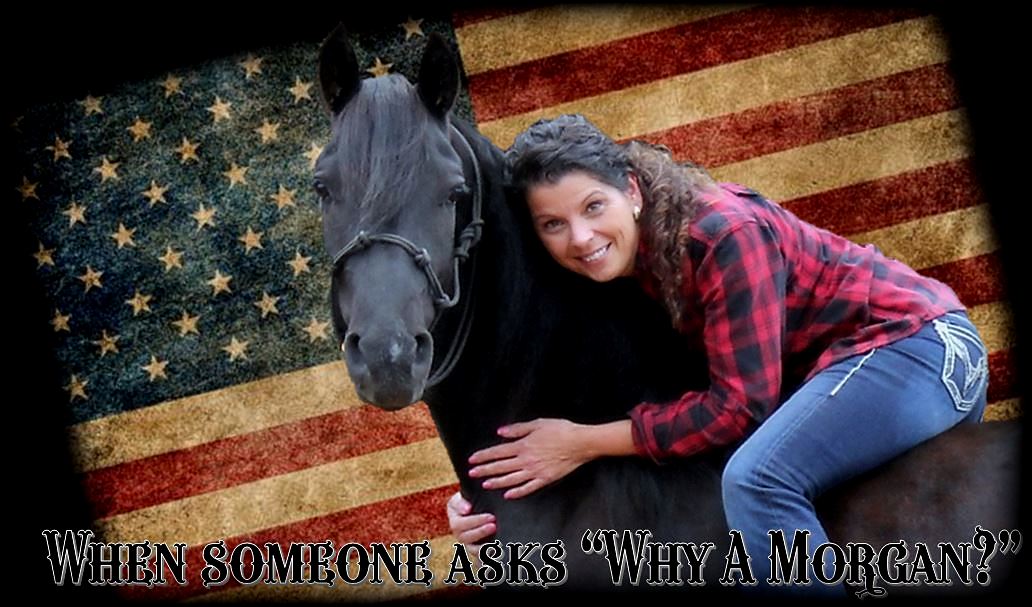
We are captivated by the Morgan horse because of their wonderful people loving temperament and willingness to learn along with their incredibly beautiful style. They are noted for their proud carriage with an upright graceful neck, a beautiful head with expressive eyes, a deep compact body with strength and athleticism, and the versatility to excel in many disciplines. Their height can range from 14.2H to 15.2H, and their forward movement is powerful yet elegant and simply breathtaking. Their intelligence and good sense combined with their soundness and stamina has allowed this horse to excel under western tack moving cattle, western pleasure, reining or trail riding and they are ridden in english tack excelling in everything from dressage, english pleasure to jumping and they are excellent driving horses under harness. Their ability to perform in a variety of disciplines attracts them to people of all ages from all walks of life. They come in a rainbow of colors to meet everyone's fancy for style.The Morgan horse is the first American breed and will steal your heart . . . once you have one, more will follow. A Morgan will be your partner for life ~
